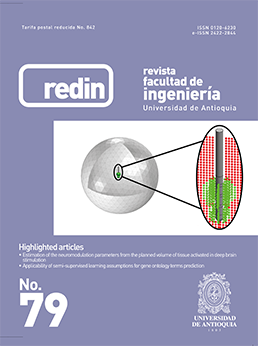Análisis envolvente de datos y algoritmo genético de Pareto aplicado a diseño robusto en sistemas multirespuesta
DOI:
https://doi.org/10.17533/udea.redin.n79a11Palabras clave:
métodos Taguchi, algoritmo genético Pareto, análisis envolvente de datos, diseño robustoResumen
Se presenta el uso de Análisis Envolvente de Datos (AED) para priorizar y seleccionar soluciones encontradas por un Algoritmo Genético de Pareto (AGP) a problemas de diseño robusto en sistemas multirespuesta con muchos factores de control y ruido. El análisis de eficiencia de las soluciones con AED muestra que el AGP encuentra una buena aproximación a la frontera eficiente. Además, se usa AED para determinar la combinación del nivel de ajuste de media y variación de las respuestas del sistema, y con la finalidad de minimizar el costo económico de alcanzar dichos objetivos. Al unir ese costo con otras consideraciones técnicas y/o económicas, la solución que mejor se ajuste con un nivel predeterminado de calidad puede ser seleccionada más apropiadamente.
Descargas
Citas
G. Taguchi, Systems of experimental design, 4th ed. Dearborn, USA: American Supplier Institute, 1991.
T. Robinson, C Borror and R. Myers, “Robust Parameter Design: A Review”, Quality & Reliability Engineering Internation, vol. 20, no. 1, pp. 81-101, 2004.
H. Allende, E. Canessa and J. Galbiati, Diseño de experimentos industriales, 1st ed. Valparaíso, Chile: Universidad Técnica Federico Santa María, 2005.
H. Allende, D. Bravo and E. Canessa, “Robust design in multivariate systems using genetic algorithms”, Quality & Quantity, vol. 44, no. 2, pp. 315-332, 2010.
S. Maghsoodloo and C. Chang, “Quadratic loss functions and signal-to-noise ratios for a bivariate response”, Journal of Manufacturing Systems, vol. 20, no. 1, pp. 1-12, 2001.
W. Wan and J. Birch, “Using a modified genetic algorithm to find feasible regions of a desirability function”, Quality & Reliability Engineering International, vol. 27, no. 8, pp. 1173-1182, 2011.
J. Holland, Adaptation in Natural and Artificial Systems: An Introductory Analysis with Applications to Biology, Control, and Artificial Intelligence, 1st ed. Ann Arbor, USA: MIT Press, 1974.
C. Lin, C. Anderson, M. Hamada, L. Moore and R. Sitter, “Using Genetic Algorithms to Design Experiments: A Review”, Quality & Reliability Engineering International, vol. 31, no. 2, pp. 155-167, 2015.
B. Forouraghi, “A Genetic Algorithm for Multiobjective Robust Design”, Applied Intelligence, vol. 12, no. 3, pp. 151-161, 2000.
E. Canessa, G. Bielenberg and H. Allende, “Robust Design in Multiobjective Systems using Taguchi’s Parameter Design Approach and a Pareto Genetic Algorithm”, Rev. Fac. Ingeniería Univ. Antioquia, no. 72, pp. 73-86, 2014.
A. Charnes, W. Cooper and E. Rhodes, “Measuring the Efficiency of Decision Making Units”, European Journal of Operational Research, vol. 2, no. 6, pp. 429-444, 1978.
D. Aigner, C. Lovell and P. Schmidt, “Formulation and Estimation of Stochastic Frontier Production Function Models”, Journal of Econometrics, vol. 6, no. 1, pp. 21- 37, 1977.
F. Ortiz, J. Simpson, J. Pigniatello and A. Heredia, “A Genetic Algorithm Approach to Multiple - Response Optimization”, Journal of Quality Technology, vol. 36, no. 4, pp. 432-450, 2004.
E. Castillo, D. Montgomery and D. McCarville, “Modified Desirability Functions for Multiple Response Optimization”, Journal of Quality Technology, vol. 28, no. 3, pp. 337- 345, 1996.
M. Farrell, “The Measurement of Productive Efficiency”, Journal of the Royal Statistical Society Series A General, vol. 120, no. 3, pp. 253-290, 1957.
W. Cooper, L. Seiford and K. Tone, Data Envelopment Analysis: A Comprehensive Text with Models, Applications, References and DEA-Solver Software, 2nd ed. New York, USA: Springer, 2007.
R. Färe, S. Groskopf, C. Lovell, The Measurement of Efficiency of Production, 1st ed. Boston, USA: KluwerNijhoff Publishing Co., 1985.
E. Canessa, C. Droop and H. Allende, “An improved genetic algorithm for robust design in multivariate systems”, Quality & Quantity, vol. 46, no. 2, pp. 665-678, 2011.
W. Vandenbrande, “Make love, not war: Combining DOE and Taguchi”, in ASQ´s 54th Annual Quality Congress Proceedings, Indianapolis, USA, 2000, pp. 450-456.
W. Vandenbrande, “SPC in paint application: Mission Impossible?”, in ASQ’s 52nd Annual Quality Congress Proceedings, Indianapolis, USA, 1998, pp. 708-715.
K. Ranjit, Design of Experiments Using the Taguchi Approach: 16 Steps to Product and Process Improvement, 1st ed. New York, USA: J. Wiley & Sons, 2001.
K. Deb, L. Thiele and E. Zitzler, “Comparison of Multiobjetive Evolutionary Algorithms: Empirical Results”, Evolutionary Computation, vol. 8, no. 2, pp. 173-195, 2000.
R. Myers, D. Montgomery and Christine M. Anderson, Response surface methodology: process and product optimization using designed experiments, 2nd ed. New York, USA: J. Wiley & Sons, 2002.
Descargas
Publicado
Cómo citar
Número
Sección
Licencia
Derechos de autor 2016 Revista Facultad de Ingeniería Universidad de Antioquia

Esta obra está bajo una licencia internacional Creative Commons Atribución-NoComercial-CompartirIgual 4.0.
Los artículos disponibles en la Revista Facultad de Ingeniería, Universidad de Antioquia están bajo la licencia Creative Commons Attribution BY-NC-SA 4.0.
Eres libre de:
Compartir — copiar y redistribuir el material en cualquier medio o formato
Adaptar : remezclar, transformar y construir sobre el material.
Bajo los siguientes términos:
Reconocimiento : debe otorgar el crédito correspondiente , proporcionar un enlace a la licencia e indicar si se realizaron cambios . Puede hacerlo de cualquier manera razonable, pero no de ninguna manera que sugiera que el licenciante lo respalda a usted o su uso.
No comercial : no puede utilizar el material con fines comerciales .
Compartir igual : si remezcla, transforma o construye a partir del material, debe distribuir sus contribuciones bajo la misma licencia que el original.
El material publicado por la revista puede ser distribuido, copiado y exhibido por terceros si se dan los respectivos créditos a la revista, sin ningún costo. No se puede obtener ningún beneficio comercial y las obras derivadas tienen que estar bajo los mismos términos de licencia que el trabajo original.










 Twitter
Twitter